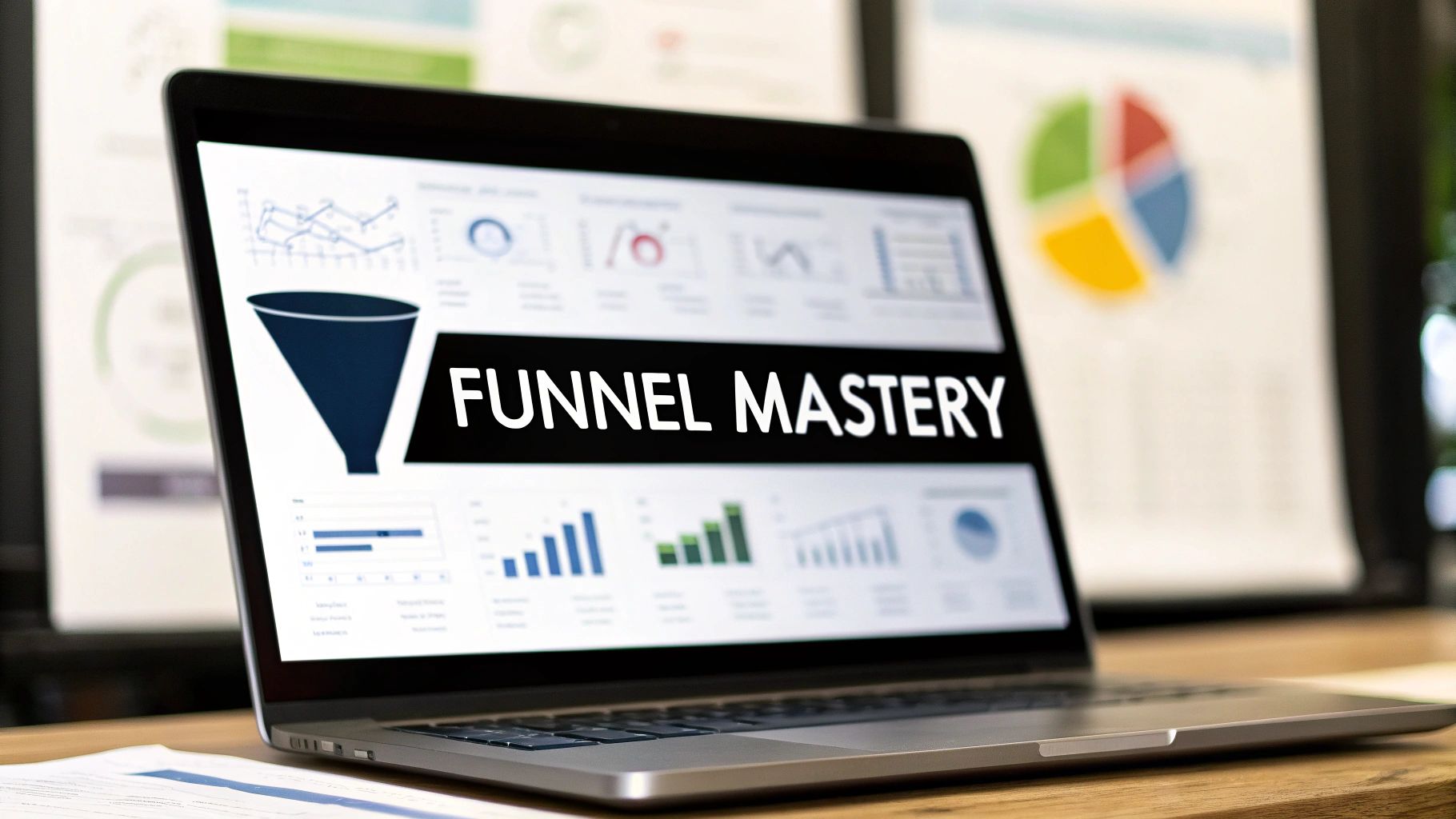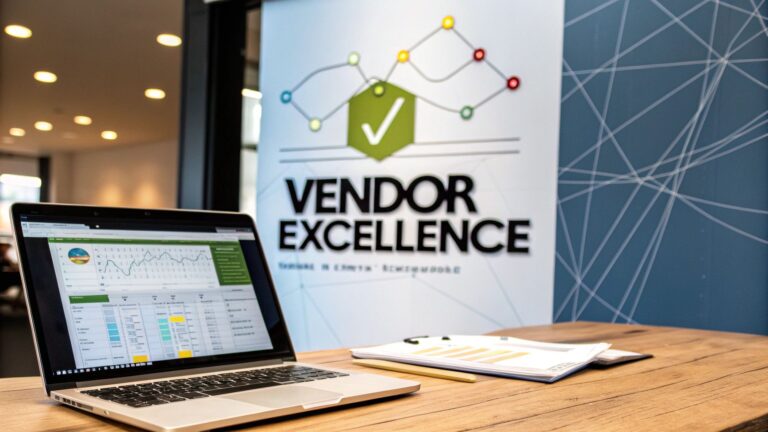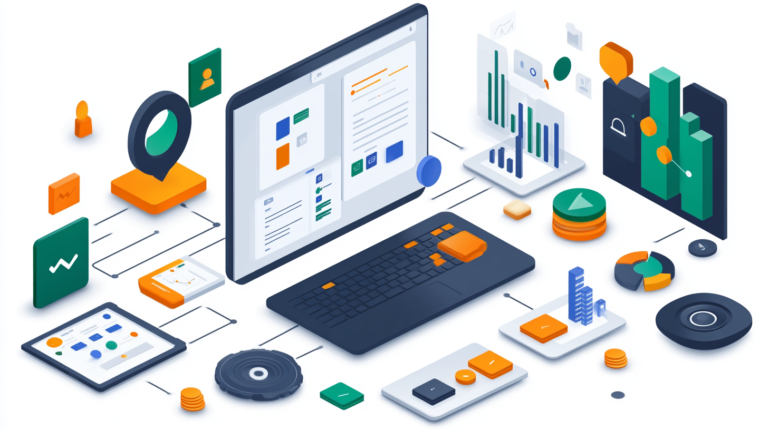10 Potent Sales Funnel Optimization Strategies for 2025
In the competitive B2B and SaaS landscape, a standard sales funnel is no longer enough. Every stage, from initial awareness to final conversion, represents a potential point of failure where significant revenue leaks out. Ignoring these leaks means leaving money on the table, acquiring customers at a higher cost, and ultimately falling behind more efficient competitors. The difference between stagnant growth and scalable success often lies in meticulous, data-driven funnel refinement.
This article provides a direct, no-filler guide to the most impactful sales funnel optimization strategies used by high-growth companies. We will move beyond generic advice and dive into ten actionable tactics designed to plug those leaks and transform your process into a high-performance conversion engine. You will learn how to implement everything from advanced A/B testing and dynamic personalization to sophisticated retargeting and multi-channel attribution.
Each strategy is broken down into practical steps you can apply immediately to improve engagement, shorten sales cycles, and maximize the return on your marketing investment. Get ready to turn your leaky funnel into a streamlined, revenue-generating machine.
1. A/B Testing and Multivariate Testing
One of the most foundational sales funnel optimization strategies is implementing a systematic testing protocol. A/B testing (or split testing) is a method where you compare two versions of a single element, like a webpage or an email, to see which one performs better. By showing version A to one group of users and version B to another, you can definitively measure which variant achieves a higher conversion rate.
Multivariate testing takes this concept a step further by simultaneously testing multiple variables on a single page. For example, instead of just testing one headline against another, you could test two different headlines, three different images, and two different call-to-action (CTA) buttons all at once. This method is more complex but reveals which combination of elements produces the best results, helping you understand how different elements interact with each other.
How to Implement Testing Effectively
To get started, focus on high-impact pages within your funnel, such as your pricing page, a demo request landing page, or a key email in your onboarding sequence. Use platforms like Optimizely, VWO, or Google Optimize to set up your experiments.
- Test one variable at a time for A/B tests to ensure clear attribution.
- Ensure statistical significance before declaring a winner; a 95% confidence level is standard.
- Prioritize high-impact elements like headlines, CTAs, and hero images first.
- Run tests for a full business cycle (e.g., a week or a month) to account for fluctuations in user behavior.
The following infographic summarizes the core concepts of these testing methods for quick reference.
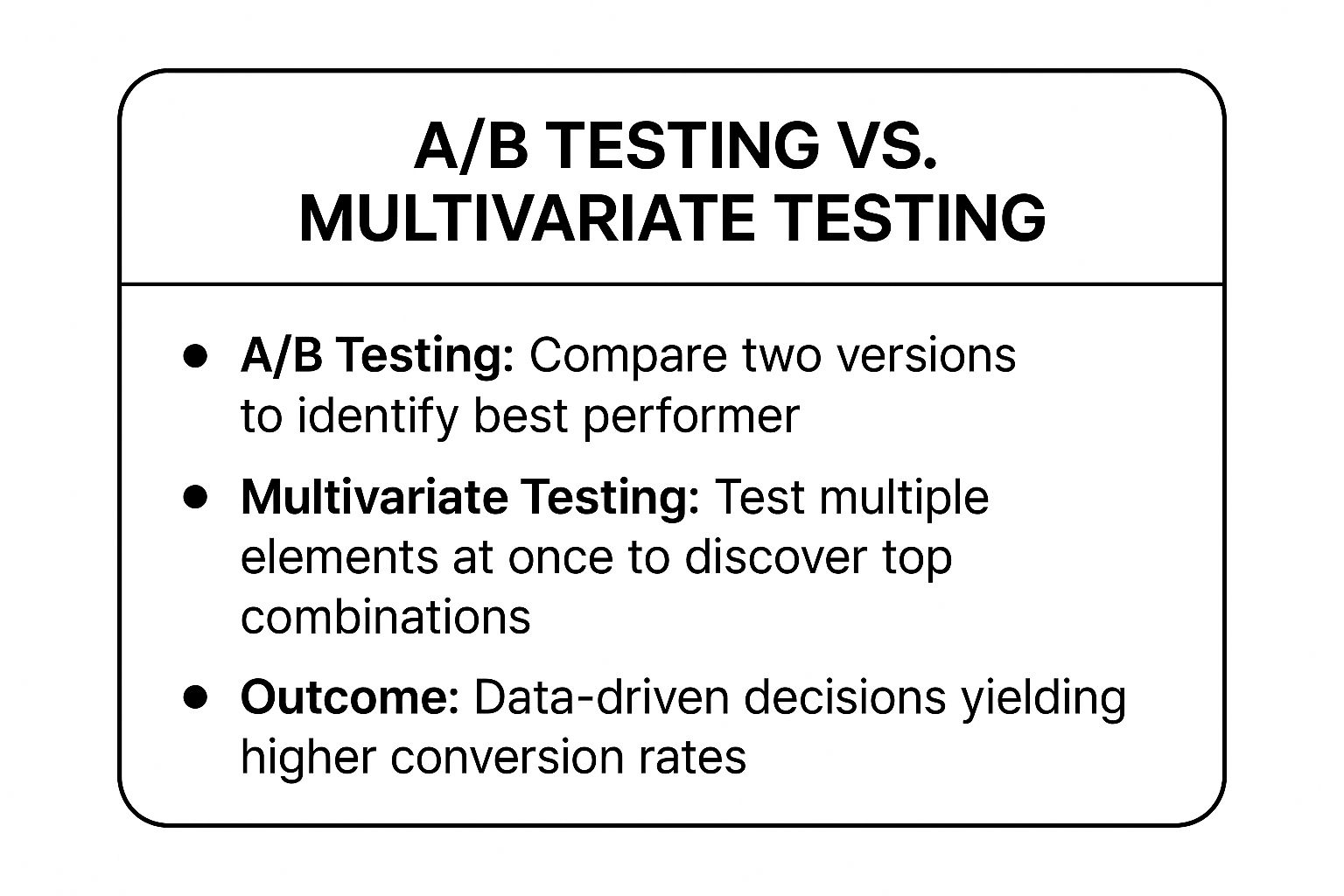
This visual highlights how both testing approaches lead to the same critical outcome: data-driven decisions that replace guesswork with evidence, directly improving your conversion rates.
2. Lead Magnets and Content Upgrades
One of the most effective top-of-funnel optimization strategies is to offer high-value resources in exchange for contact information. Lead magnets, such as ebooks, templates, or webinars, attract potential customers by providing an immediate solution to a specific problem. They act as the initial handshake, converting anonymous website visitors into identifiable leads who have shown interest in your expertise.
Content upgrades are a more targeted version of this concept. Instead of a site-wide offer, a content upgrade is a resource created specifically to complement a particular blog post or page. For instance, a post about project management could offer a downloadable project plan template. This hyper-relevant approach significantly boosts conversion rates because the offer directly aligns with the user's current intent.
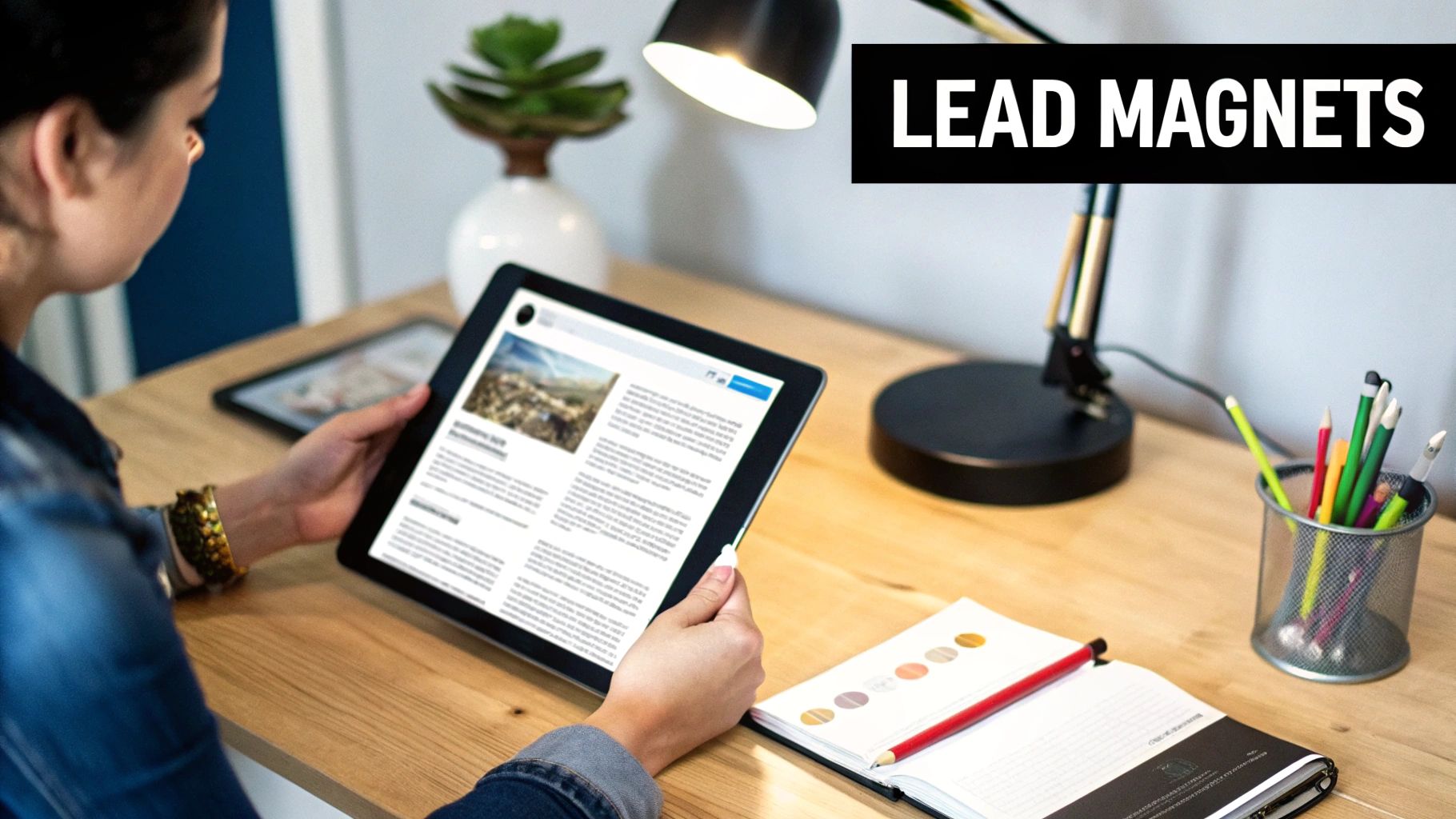
How to Implement Lead Magnets Effectively
Start by identifying the most pressing pain points of your ideal customer. A great example is HubSpot, which generates thousands of leads by offering free marketing and sales templates. The key is to create a resource that is too valuable for your target audience to ignore, turning a simple content offer into a powerful lead generation engine. Once you capture these leads, you can improve your qualification process. You can discover more about qualifying prospects with lead scoring best practices.
- Solve a specific, urgent problem for your target audience.
- Create content upgrades for your highest-traffic blog posts to maximize impact.
- Use compelling headlines that clearly communicate the benefit of the download.
- Keep signup forms simple, asking only for essential information like an email address.
- Deliver the resource immediately via an automated email to build trust and momentum.
3. Email Nurture Sequences
One of the most powerful sales funnel optimization strategies is implementing automated email nurture sequences. These are a series of targeted emails designed to build relationships, provide value, and guide prospects through the funnel based on their actions. Instead of sending generic blasts, nurture sequences deliver highly relevant content at optimal times, such as after a user downloads a resource or signs up for a trial, significantly increasing engagement and conversion rates.
This approach is highly effective because it automates the process of building trust and educating leads. For example, MasterClass famously uses a multi-email sequence that helps convert 8% of its free trial users into paying customers by showcasing value and creating a sense of urgency. Similarly, Grammarly's educational email sequence maintains impressive open rates by consistently offering helpful writing tips.
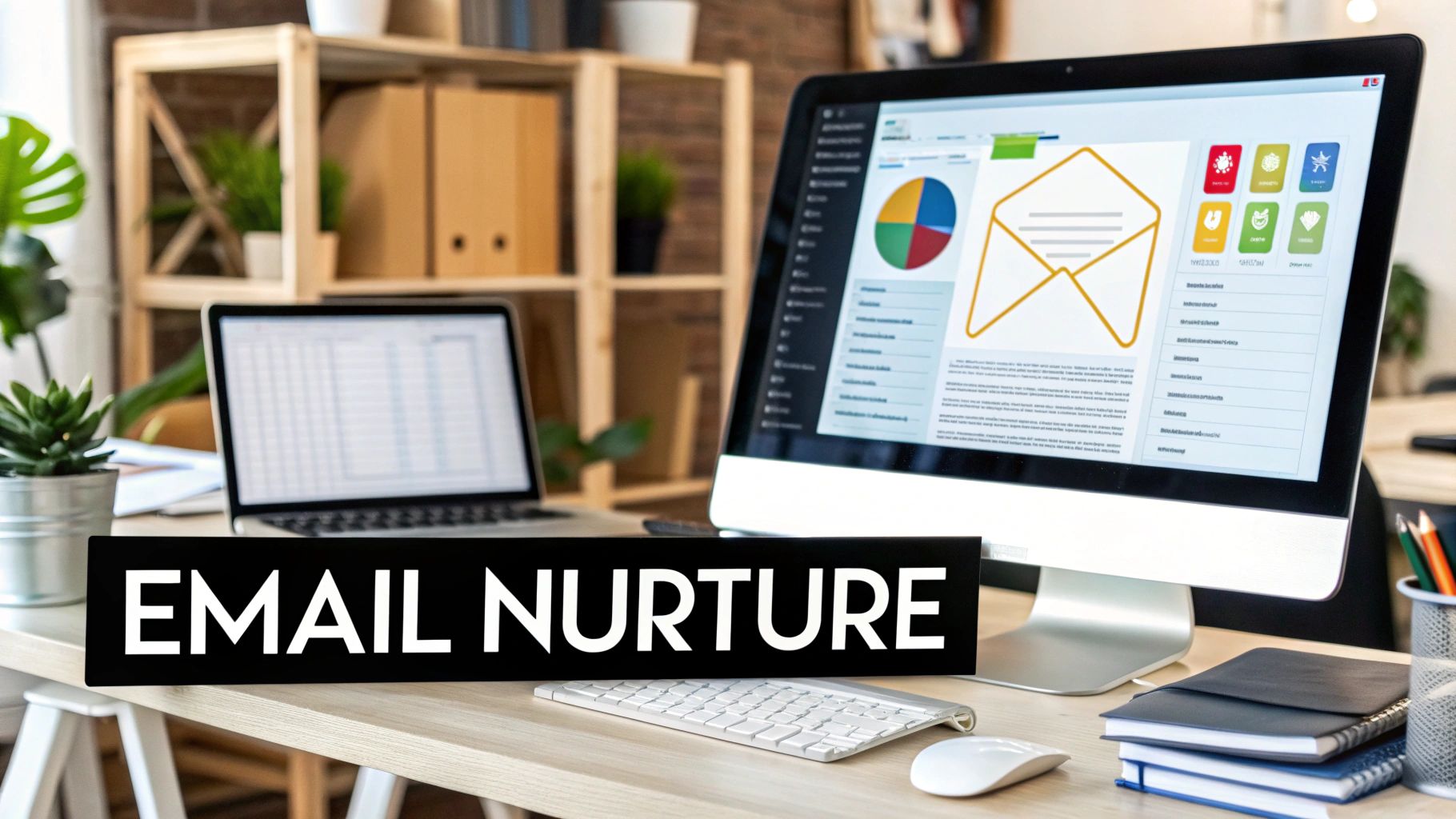
How to Implement Nurture Sequences Effectively
To begin, map out the key trigger points in your customer journey and build a sequence for each. Platforms like ConvertKit, ActiveCampaign, or Mailchimp are excellent for creating these automated workflows. Learn more about the fundamentals of these systems by reading about automated email marketing campaigns.
- Start sequences promptly, ideally within 24 hours of a user's action, to capitalize on their initial interest.
- Mix educational content with soft promotional messages to build authority before asking for the sale.
- Use a clear, single call-to-action (CTA) in each email to guide the user to the next logical step.
- Test subject lines and send times regularly to maximize open rates and engagement.
- Segment your audience to deliver hyper-relevant content that speaks directly to their specific needs and pain points.
This strategy transforms a cold lead into a warm, educated prospect who is much more likely to convert when they finally interact with your sales team.
4. Landing Page Optimization
Landing page optimization is the process of improving every element on a dedicated campaign page to maximize conversions. Unlike a standard webpage with multiple navigation options, a landing page is designed with a single, focused goal, such as signing up for a trial or downloading a whitepaper. Optimizing these pages is a critical sales funnel optimization strategy because they are often the first direct interaction a lead has with your offer.
Companies like Unbounce and Instapage have built their entire businesses around this discipline. The goal is to create a seamless experience that guides the user directly to the desired action by refining headlines, copy, imagery, and forms. Effective landing pages ensure the message promised in an ad is delivered clearly and persuasively, directly impacting lead generation and acquisition costs.

How to Implement Landing Page Optimization
Start by analyzing your highest-traffic landing pages. A small conversion lift on these pages can yield significant results. For example, Basecamp's simple, benefit-focused landing pages consistently convert at over 15% by focusing on clarity and a single call-to-action.
- Match your message: Ensure the headline and copy on your landing page perfectly align with the ad or link the visitor clicked to get there. This creates a consistent and trustworthy experience.
- Simplify your forms: Only ask for essential information. Eliminating unnecessary fields reduces friction and can dramatically increase form submission rates.
- Leverage social proof: Include testimonials, case study snippets, or client logos to build credibility and trust with new visitors.
- Design for action: Use a high-contrast color for your call-to-action (CTA) button and place important elements like your form "above the fold" so users don't have to scroll to see them.
5. Retargeting and Remarketing Campaigns
One of the most effective sales funnel optimization strategies for recovering lost leads is implementing retargeting and remarketing campaigns. This digital advertising approach targets users who have previously visited your website or interacted with your brand but did not convert. By using tracking tools like the Facebook Pixel or Google Ads tag, you can deliver personalized ads to these warm prospects as they browse other websites, use social media, or watch videos, effectively guiding them back into your funnel.
The core principle is simple: not everyone is ready to buy on their first visit. Retargeting keeps your brand top-of-mind, reminding prospects of the value you offer and giving them another opportunity to convert. For instance, a user who viewed your pricing page but didn't sign up for a demo might see an ad on LinkedIn highlighting a specific feature or a time-sensitive offer. This re-engagement is crucial for maximizing your initial marketing investment.
How to Implement Retargeting Effectively
To launch successful campaigns, use platforms like Google Ads, Facebook Ads, or AdRoll to build and manage your audiences. The key is segmentation and personalization to avoid generic, ineffective ads.
- Segment audiences based on specific actions, such as pages visited (e.g., pricing page vs. blog post), time spent on site, or items added to a cart.
- Create different ad creative for each funnel stage. A top-of-funnel visitor needs brand awareness content, while a bottom-of-funnel prospect may respond better to a direct call-to-action.
- Set appropriate frequency caps to prevent ad fatigue, which can create a negative brand perception. Showing the same ad too often will annoy potential customers.
- Exclude converted customers from acquisition campaigns to avoid wasting ad spend and irritating new clients with irrelevant offers.
6. Social Proof Integration
One of the most potent sales funnel optimization strategies is the integration of social proof. This psychological principle, popularized by Robert Cialdini in his book Influence, suggests that people are more likely to take an action if they see others doing it. By strategically placing testimonials, case studies, reviews, and client logos throughout your funnel, you reduce friction and purchase anxiety, making it easier for prospects to trust your brand and convert.
Social proof acts as a powerful validator, especially in B2B and SaaS where purchase decisions involve significant investment and risk. Seeing that other reputable companies have achieved success with your solution provides the confidence needed to move forward. For example, Basecamp prominently displays customer logos on its homepage, a tactic that helped boost its enterprise sales. Similarly, platforms like G2 and Trustpilot have built entire business models around providing credible, third-party validation.
How to Implement Social proof Effectively
Integrating social proof is not just about adding a testimonial to your homepage; it's about placing the right proof at the right stage of the buyer's journey. For instance, a detailed case study is more effective at the consideration stage, while a quick testimonial is perfect near a CTA button.
- Place testimonials near conversion points like signup forms or pricing pages to overcome last-minute hesitation.
- Use specific numbers and results in case studies (e.g., "Increased lead generation by 150%") to demonstrate tangible value.
- Include photos and full names with testimonials to enhance authenticity and build a human connection.
- Display social proof from similar customer segments to make it more relatable to your target audience.
- Rotate and test different forms of proof (e.g., video testimonials vs. written quotes) to see what resonates best.
7. Funnel Analytics and Attribution Modeling
Understanding precisely how users navigate your sales funnel is impossible without robust analytics and clear attribution modeling. Funnel analytics involves tracking and analyzing the customer journey, from the first touchpoint to the final conversion. It helps you visualize where potential customers drop off, what paths they take, and how long each stage lasts.
Attribution modeling complements this by assigning credit to the marketing touchpoints that influence a conversion. Instead of giving all the credit to the final click, models like linear, time-decay, or data-driven attribution distribute value across the entire journey. This provides a far more accurate picture of which channels and campaigns are truly driving results, allowing for smarter budget allocation and one of the most impactful sales funnel optimization strategies. For example, Adobe Analytics helped Nike identify customer journey gaps worth an estimated $50M in optimization opportunities by understanding these complex paths.
How to Implement Testing Effectively
To leverage analytics and attribution, you must move beyond basic page-view tracking. Start by defining the key conversion events at each funnel stage and use platforms like Google Analytics 4, Mixpanel, or HubSpot to build and monitor your funnel reports.
- Set up conversion tracking for every important user action, including demo requests, content downloads, and trial sign-ups.
- Use UTM parameters consistently across all campaigns to ensure accurate source and medium tracking.
- Implement first-party data collection strategies to gain deeper insights and prepare for a cookieless future.
- Regularly audit your tracking setup to catch any errors or inconsistencies that could skew your data.
- Create custom dashboards in your analytics tool to provide key stakeholders with a clear, at-a-glance view of funnel performance.
8. Progressive Profiling
One of the biggest friction points in a sales funnel is a long, intimidating form. Progressive profiling is a powerful strategy that solves this by gathering lead information gradually over time. Instead of asking for ten pieces of data upfront, you start with a few essential fields and then ask for more information on subsequent visits or interactions. This approach respects the user's time, significantly reduces form abandonment, and builds a rich, detailed customer profile with each touchpoint.
Marketing automation platforms like HubSpot and Marketo pioneered this technique, recognizing that it improves the user experience while still collecting vital data. As a lead engages more with your content, smart forms can dynamically swap out fields they've already completed for new ones. For example, on their first visit, you might ask for their name and email. On their second, you might ask for their company name and size. This incremental data collection is a key component of effective sales funnel optimization strategies, as it directly increases lead quality without scaring potential customers away.
How to Implement Progressive Profiling Effectively
To begin, identify the key data points you need at each stage of the buyer's journey. Use a marketing automation platform that supports smart or progressive forms to manage the logic.
- Start with essential information only, like name and email, to keep the initial barrier low.
- Use behavioral data to decide what to ask next. If a user downloads a case study, ask about their industry; if they view a pricing page, ask about their budget.
- Avoid asking for the same data twice. Use smart fields that recognize returning visitors and pre-populate known information.
- Be transparent about why you need the information. A small note like "to tailor your demo experience" can boost completion rates.
This method transforms data collection from a one-time transaction into an ongoing conversation, building trust and providing your sales team with a highly qualified, context-rich lead profile.
9. Personalization and Dynamic Content
One of the most powerful sales funnel optimization strategies is moving away from a one-size-fits-all approach. Personalization involves tailoring content, offers, and experiences based on individual user data, behavior, and firmographics. By using technology to deliver uniquely relevant messaging at scale, you create a more engaging journey that directly addresses the prospect's specific needs and context, significantly boosting conversion rates.
This strategy transforms a generic sales funnel into a series of individualized pathways. For instance, Amazon's recommendation engine is famously responsible for a huge portion of its revenue by showing users products they are most likely to buy. Similarly, a SaaS company can dynamically change its website's hero section to reflect the industry of the visitor, immediately establishing relevance and building rapport from the first interaction.
How to Implement Personalization Effectively
To get started, leverage user data to create customized experiences at critical touchpoints in your funnel. Platforms like Dynamic Yield or Adobe Target can help automate this process, but you can begin with simpler tactics.
- Start with simple personalization like using a prospect's name and company in email outreach.
- Segment your audience based on behavior (e.g., pages visited, content downloaded) to deliver targeted follow-up campaigns.
- Use dynamic CTAs that change based on a user’s funnel stage, such as showing "Request a Demo" to new visitors and "Talk to Sales" for returning leads.
- Implement product or content recommendations based on past browsing history to keep users engaged and guide them toward a solution.
By integrating personalization, you make each prospect feel understood. This level of customization is a key differentiator that turns passive interest into active engagement. Learn more about how to get started with marketing automation best practices that power these dynamic experiences.
10. Multi-Channel Funnel Integration
A modern buyer's journey is rarely linear; it spans multiple touchpoints across various channels. Multi-channel funnel integration involves creating a seamless and consistent customer experience across email, social media, paid ads, content, and sales interactions. This holistic approach ensures your messaging is coherent and that transitions between channels are smooth, preventing leads from falling through the cracks. The goal is to make every interaction feel like a continuous conversation, regardless of the platform.
This strategy moves beyond siloed channel performance to create a synergistic effect where each touchpoint supports the others. For instance, a user might discover your brand through a LinkedIn ad, read a blog post on your website, receive a follow-up email, and then engage with a sales representative. An integrated funnel ensures this journey is fluid, with each step logically following the last. Companies like Sephora have perfected this, using their omnichannel strategy to achieve 80% higher purchase frequency from customers who engage across multiple channels.
How to Implement Multi-Channel Integration Effectively
To begin integrating your channels, you must map the typical customer journey and identify key transition points. Use platforms like HubSpot or Salesforce Marketing Cloud to create a unified view of customer data, which is essential for personalization and consistent messaging.
- Ensure consistent branding and messaging across all platforms.
- Use a Customer Data Platform (CDP) to create a single, unified profile for each lead.
- Implement cross-channel retargeting to re-engage users on different platforms (e.g., show a Facebook ad to someone who visited your pricing page).
- Create channel-specific content that aligns with your overarching campaign goals.
- Regularly test channel combinations to see which paths produce the highest conversion rates.
This approach is one of the most powerful sales funnel optimization strategies because it meets customers where they are, building trust and momentum at every stage of their journey.
Sales Funnel Optimization Strategies Comparison
| Strategy | Implementation Complexity | Resource Requirements | Expected Outcomes | Ideal Use Cases | Key Advantages |
|---|---|---|---|---|---|
| A/B Testing and Multivariate Testing | Medium to High (setup complexity) | Requires traffic volume and technical expertise | Data-driven decisions, higher conversion rates | Optimizing sales funnels, element testing | Low risk, measurable ROI, continuous improvement |
| Lead Magnets and Content Upgrades | Low to Medium | Content creation and promotion efforts | Builds qualified leads, audience segmentation | Lead generation, list building | Cost-effective, establishes authority, immediate value |
| Email Nurture Sequences | Medium | Requires initial content development, automation tools | Increased conversions, scalable relationship building | Relationship nurturing, onboarding, conversions | Automated 24/7 marketing, personalized messaging |
| Landing Page Optimization | Medium | Design, copywriting, and testing resources | Higher conversion rates, improved ad ROI | Campaign-specific pages | Focused CTAs, improved user experience, better tracking |
| Retargeting and Remarketing Campaigns | Medium to High | Ad spend, pixel setup, creative development | Increased conversions from warm audiences | Re-engagement, cart abandonment recovery | Higher conversion rates, brand recall, detailed attribution |
| Social Proof Integration | Low to Medium | Collection and display of testimonials/reviews | Builds trust quickly, reduces purchase hesitation | Increasing trust and credibility | Cost-effective, authentic content, boosts conversions |
| Funnel Analytics and Attribution Modeling | High | Advanced setup, analytics tools, training | Clear ROI, optimization insights | Marketing performance analysis | Data-driven budget allocation, reveals customer behavior |
| Progressive Profiling | Medium to High | Marketing automation, form design | Reduced form abandonment, better data quality | Lead data enrichment, personalization | Improves user experience, builds profiles gradually |
| Personalization and Dynamic Content | High | Data collection, AI tools, technical integration | Higher engagement, loyalty, and conversion | Tailored experiences, behavior-based targeting | Increased conversion, better customer experience |
| Multi-Channel Funnel Integration | High | Cross-channel tech integration, coordination | Cohesive experiences, improved campaign ROI | Omnichannel marketing strategies | Consistent messaging, synergy between channels |
Turn Your Funnel into a Growth Engine with Automation
We've explored a comprehensive suite of powerful sales funnel optimization strategies, from the granular details of A/B testing and progressive profiling to the broad strokes of multi-channel integration. Each strategy, whether it’s deploying compelling lead magnets, personalizing content, or leveraging social proof, acts as a critical lever for improving conversion rates and driving revenue. But the true power doesn't lie in implementing just one or two of these tactics in isolation.
The path to a high-performance sales funnel is paved with continuous improvement. It’s a dynamic process of testing, learning, and refining every touchpoint your prospects encounter. Viewing your funnel not as a static pathway but as a living ecosystem is the first step toward unlocking its full potential. The goal is to move beyond simply plugging leaks and start proactively engineering a seamless, personalized, and compelling customer journey from initial awareness to final conversion and beyond.
From Manual Effort to Scalable Systems
Managing these interconnected strategies manually can quickly become overwhelming. Juggling analytics, running retargeting ads, segmenting email sequences, and personalizing landing pages across different platforms is a recipe for inefficiency and missed opportunities. This is where automation becomes the ultimate force multiplier. By systemizing these processes, you free up your team to focus on high-level strategy and creative problem-solving instead of repetitive, time-consuming tasks.
Implementing robust automation allows you to:
- Execute with Precision: Trigger personalized email sequences based on specific user actions, ensuring timely and relevant communication.
- Scale Your Efforts: Deliver dynamic content to thousands of prospects simultaneously without sacrificing the quality of the individual experience.
- Gather Smarter Data: Automatically track key metrics across your entire funnel, providing a clear view of what’s working and where to focus your optimization efforts next.
The Ultimate Takeaway: Build a Predictable Growth Machine
Mastering these sales funnel optimization strategies is about more than just incremental gains. It's about transforming your sales and marketing operations from a series of disjointed activities into a predictable, scalable, and automated growth engine. When each stage is optimized and every action is tracked, your funnel stops being a source of uncertainty and becomes your most reliable driver of business growth. By embracing a data-driven mindset and leveraging the power of automation, you can build a system that consistently attracts, nurtures, and converts high-quality leads, propelling your business toward its most ambitious goals.
Ready to stop manually piecing together your sales funnel and start building a truly automated growth engine? Discover how MakeAutomation can seamlessly connect your tools, automate your workflows, and implement these advanced strategies at scale. Visit MakeAutomation to see how our platform can transform your funnel optimization process.

